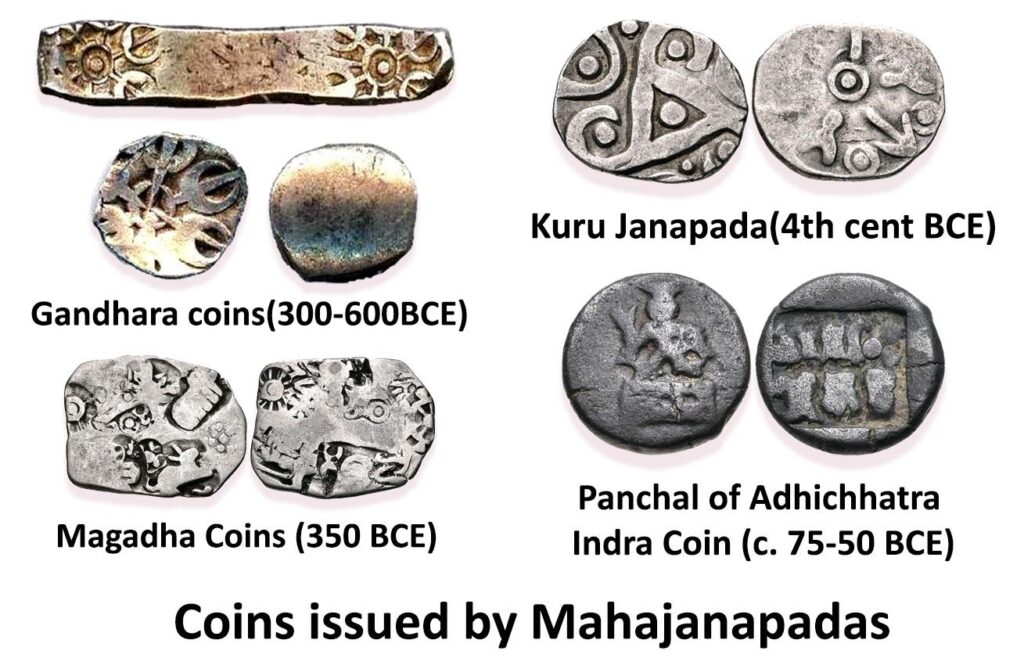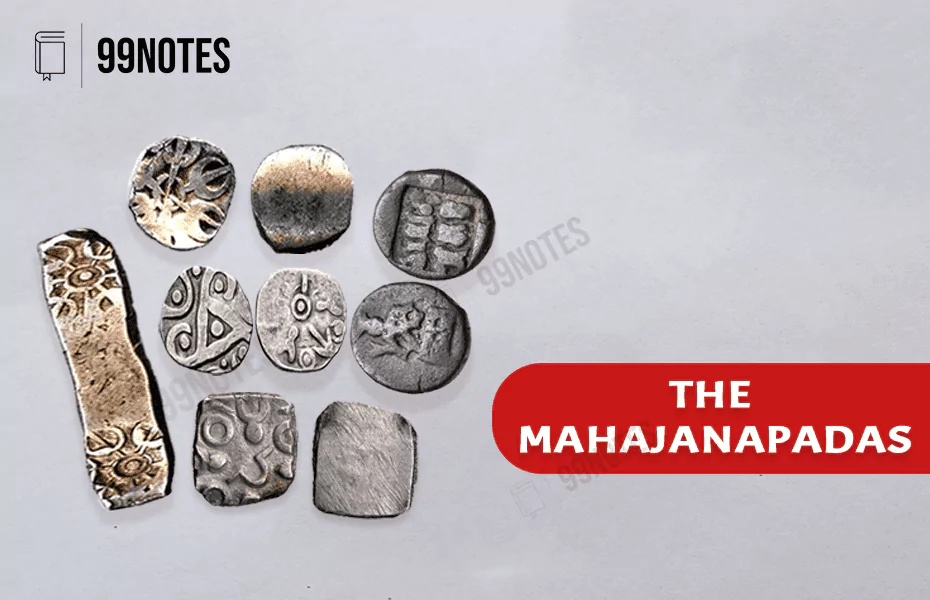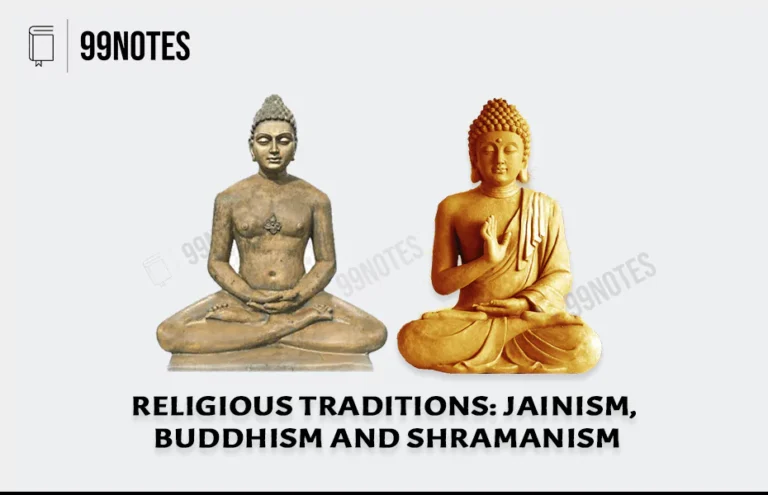16 Mahajanapadas – History, Capital and Location
Mahajanapadas Overview
The term Mahajanapadas refers to the great kingdoms or republics of ancient India, established around the 6th century BCE. These entities marked the beginning of recorded history in the Indian Subcontinent, showcasing diverse forms of governance. The word Mahajanapada comes from two word Maha + Janapada, here Maha means Great and ‘Janapada’ (spelt as Janpad) comes from the Sanskrit root Jana meaning a tribe, and pada meaning feet. Thus, ‘Janapada’ means the area where the people of the ‘Jana’ tribe set foot.
-
- In Vedic society, a clan was essentially a pastoral group constantly moving in search of greener pastures. This meant that the area of the ‘Janapada’ changed frequently. Nevertheless, getting control of the best pasture land became the prime political motive in the Vedic period.
-
- However, in the later Vedic period (1000BCE – 600BCE), the members of the ‘Jana’ took up agriculture and began to settle down. These fixed agricultural settlements, i.e. the Janapadas, transformed into territories of the state.
From the 6th century BCE onwards, some Janapads developed into Mahajanapadas (spelt as mahajanpadas). The Formation of states or Rashtra is a distinguishing feature of this age, which could be both monarchical and republican.
This change is attributed to a series of developments in the socio-economic structures, such as:
- The land now became the most important source of wealth instead of cattle.
- In addition, Iron weapons caused the warrior class to play a more significant role in political life.
- The new agricultural tools and implements led to surplus production, which the state could tax to meet its military and administrative needs.
- Towns started developing due to surplus production and increasing trade activities

The 16 Mahajanapadas
16 Mahajanapadas are mentioned in the Buddhist and later Vedic texts. These Mahajanapadas were a conglomerate of thousands of villages and a few towns. They extended from North Western Pakistan to Bengal and from the sub-montane regions of the Himalayas to the Godavari.

The Buddhist text Anguttara Nikaya of the Sutta–Pitaka gives the list of the following 16 Mahajanapadas with capital in the time of Buddha:
| 16 Mahajanapadas Name | Mahajanapadas Capitals | Important Facts |
| 1. Anga | Champa | Magadha mahajanapad swallowed it up during Bimbisara’s rule.Its capital Champa is located at the confluence of Ganga and Champa. |
| 2. Magadha | Rajgriha | Became a centre of Jainism and Buddhism. The second Buddhist council was organized here. |
| 3. Kasi | Kasi | The capital city got its name from the rivers Varuna and Asi, as mentioned in Matsya Purana.Initially, it was powerful, but eventually, it had to submit to the power of Koshala. |
| 4. Vatsa/Vamsa | Kausambi | Vatsa were a breakaway Kuru clan which shifted from Hastinapur and settled down at Kaushambi.Located on the banks of Yamuna. |
| 5. Kosala | Shravasti (Northern) Kushavati (Southern) | Prasenjit was an important king. He was a contemporary of Buddha. |
| 6. Shurasena | Mathura | Its capital was Mathura, situated on the banks of the Yamuna. |
| 7. Panchala | Achchhitara & Kamilaya | Like Kuru, it no longer enjoyed the political importance that it had attained in the later Vedic period.Kannauj city was situated here.Later the nature of governance changed from a monarchy to a republic. |
| 8. Kuru | Indraprastha | The story of Mahabharta is about Kurus.Here also nature of governance changed from a monarchy to a republican. |
| 9. Matsya | Viratnagar | It was founded by Virata and situated around the present-day Jaipur, Alwar and Bharatpur areas of Rajasthan. |
| 10. Chedi | Sothivati | Shishupala was king here, mentioned in the Mahabharata war. |
| 11. Avanti | Ujjaini Or Mahishmati | It was an important place in terms of the development of Buddhism. |
| 12. Gandhara | Taxila | An important centre of international trade.Persians captured it in the later part of the Mahajanapada period. |
| 13. Kamboja | Pooncha | It was located on the Uttarapatha and was known for its excellent breed of horses. |
| 14. Asmaka/ Assaka | Pratisthan/ Paithan | It was situated along the river Godavari on the Dakshinapath.It was the only Mahajanapada situated beyond the Vindhya range. |
| 15. Vajji | Vaishali | It was a republic with many clans, e.g. Lichchavis (capital Vaishali), Videhans (capital Mithila), and Jnatrikas (Mahavira belonged to this clan), ruling in consonance.Ajatshatru of Magadha defeated them. |
| 16. Malla | Kushinara | It was a republic.Gautam Buddha attained Mahaparinirvana in the capital city of Kushinara. |
However, the Anguttara Nikaya fails to mention several important Janapadas still. For example, Kalinga grew into a powerful kingdom after the Magadha’s reign. Vanga later developed into Banga(Bengal). The Andhras later evolved into a powerful Satvahana dynasty.
Nevertheless, 4 of the 16 Mahajanapadas grew into even stronger kingdoms.
4 Major Mahajanapadas
Out of the 16, 4 mahajanapadas, namely Magadh, Kosala, Avanti and Vatsa, fought amongst themselves for supremacy. Ultimately, Magadha emerged victorious and became the most powerful kingdom in northern India.
1. Avanti Mahajanapad
-
- It was situated in the modern-day Malwa Plateau and had Ujjaini as its northern capital and Mahishmati as its southern capital.
- Avanti had a significant place in the development of Buddhism.
- During the lifetime of Buddha, Chandra Pradyota riled Avanti.
- It was finally annexed by Magadha in the 4th century BC.
2. Kosala Mahajanapad
- It was located in modern-day eastern Uttar Pradesh, particularly the Awadh region, and had its capital at Shravasti.
- It included the tribal republican territory of the Shakyas of Kapilvastu, which is also associated with the birthplace of Gautam Buddha.
- Ayodhya was an important city.
3. Vatsa Mahajanapad
-
- It was situated along the bank of Yamuna, with its capital at Kaushambi near Prayagraj.
- The ruler Udayana made Buddhism a state religion.
- It was later annexed to the Avanti kingdom.
- It was a centre of trade and economic activities.
4. Magadha Mahajanapad
- Magadha’s eventually emerged as the most powerful empire, which consolidated most of the Mahajanapadas
- It first expanded under the leadership of Bimbisara of the Haryanka dynasty, who started a policy of conquest and aggression, which ended with the Kalinga war during the rule of Ashoka.
- By the end of this phase, Magadha controlled almost all of the Indian subcontinent.
Economy During Mahajanapadas
- Metal Technology: The use of iron is the distinguishing feature of this age. The smiths knew how to harden iron tools.
- Agriculture:
-
-
- With the introduction of Iron implements, rainfed forests could be cleared, and hard-soil areas could be turned using iron-tipped ploughshare, which allowed for large-scale cultivation and settlement.
-
- Further, the immense fertility of the alluvial soil in the newly cleared areas in the Ganga plains contributed to the growth of agriculture.
-
- Rice was the staple cereal produced in eastern Uttar Pradesh. Paddy transplantation, which means saplings were grown and then transplanted in the fields, enormously adding to the yield.
- Metal Coins/Legal tenders: Coins made of metal appeared first in the 7th -6th century BCE. The earliest coins are predominantly silver coins though a few copper coins also appear. They are called Punch-marked coins because they were punched with several specific figures, one by one.
-
-
- They were initially issued by the merchant Guilds and later by the States. They represented a trade currency, a “mark of surety” of future delivery of material. This shows the growth of intensive trade activity and urban development.
-
- The state-issued coins are attributed to two different periods: the first is the Janapadas, and the second is the Mauryans.
-
- These coins draw various natural motifs, like the sun, animal motifs, trees, hills etc., and some were geometrical symbols. However, they carry no script.

- Taxation: The warrior and Priest class, i.e., the Kshatriyas and Brahmins, were exempted from paying taxes, and the burden fell on Vaishyas or Grihapatis. Bali, a voluntary payment during the Vedic age, became compulsory, and officers called Balisadhakas were appointed to collect it. Even artisans and traders were taxed.
Polity and Administration
- The Republican Experiment: While most states were monarchies, we hear about a few Gana–Sanghas or republics as well. These were tribal oligarchies which elected the king, and he ruled with the assistance of a council. Shakyas and Lichchhavis were such republics.
- The Decline of Popular assemblies: The territorial kings discarded Sabha and Samiti, and ‘popular assemblies’ lost their relevance.
- The Emergence of a uniform Legal and Judicial System: In place of tribal laws, the Dharmasutras laid down the duties as well as civil and criminal laws according to the varna division.
-
- However, the customs and traditions of non-Vedic tribal groups were not completely ignored, which gradually got absorbed into the Brahmanical social order. As the name suggests, these were written in aphoristic (sutra) style.
-
- Retributive Justice: Rough and harsh punishments were given. In many cases, criminal offences were governed by the idea of revenge.
- Rise of cities: Each Mahajanapada had a capital which used to be fortified.
- Army: Unlike the Vedic age, now the king had a standing army.
Society and Religion during Mahajanapadas
- The Varna Division: The society was divided into four Varnas. The stature of the Brahmans saw a huge rise due to the introduction of more elaborate rituals in the later Vedic texts.
- Challenge to Brahmanas: There is a sense of competition between Brahmans and Kshatriyas for prominence. For example, both Buddha and Mahavira belonged to the Kshatriya clan but ventured into religion, which was the sole authority of the Brahmanas.
- Religion: This period is also known as the age of Buddha. We see the emergence of two important religious sects, Buddhism and Jainism, during this period. They caused several changes in the social and economic life of the people and tried to mitigate the evils that originated from the Brahmanical social order. It opened the doors for women and Shudras.
- Position of Shudras: The varna division of society took a heavy toll on Shudras, who had been relegated to the lowest status in society. They were deprived of religious and legal rights. Even the rise of Buddhism and Jainism did not materially change their position, and their general position continued to be low.
Material Life
- NBPW Phase(700-200BCE): Archaeologically, the 7th century BC marks the beginning of the Northern Black Polished Ware (NBPW) phase. It is representative pottery of the Mahajanapada era in North India. NBPW was a very glossy shining type of pottery and could have served as the tableware of wealthier people.

-
- Urbanization: The NBPW phase marked the beginning of the second urbanization in India.
-
-
- However, the structures excavated till now are far less impressive than the Harappan cities. However, they indicate a significant increase in population when compared with Painted Grey Ware (PGW) settlements.
-
- Each town played an important role as a marketplace and came to be inhabited by artisans and merchants who organized themselves into guilds(shrenis) under their respective chiefs. These guilds later developed into Jatis in the post-Mauryan period.
-
- Many cities like Mathura were bustling centres of commercial, cultural and political activity.
-
- The Art of Writing: After the end of Harappan culture, we find written markings only in this period. The Writing led to the compilation of laws and bookkeeping, which was essential to trade, tax collection and maintenance of a large professional army.

-
- Mathematics and Science:
-
-
- Shulba Sutras or Śulbasūtras: This period also produced texts dealing with sophisticated measurement (Sulvasutras). However, the earliest records have perished since they were not written on stone or metal. It contains descriptions related to the geometry of the fire-altar construction. There are four types of Shulba Sutras, which are mathematically the most significant. These are attributed to Baudhayana, Manava, Apastamba and Katyayana.
-
- Baudhayana (c. 8th century BCE) composed the Baudhayana Sulba Sutra, the best-known Sulba Sutra, which contains examples of simple Pythagorean triples, such as (3, 4, 5), (5,12,13). Baudhayana also established a way to compute the square root of two, which is the length of a diagonal of a unit square.
- Transport and Communication: Nearly all towns were along communication routes.
-
-
- Pataliputra was located on the riverine route
-
- Ujjaini was located along land routes.
-
- Many cities like Mathura were bustling centres of commercial, cultural and political activity.
Conclusion
The Mahajanapadas era stands as a pivotal period in ancient Indian history, showcasing the evolution of governance from tribal to sophisticated state systems. Among these 16 Mahajanapadas, Magadha, Kosala, Avanti, and Vatsa emerged as the most influential, with magadha ultimately dominating the landscape. The significance of this period’s is , its contributions to socio-economic advancements, the rise of major religious, and the beginnings of urbanization, laying a foundational blueprints for future Indian Civilizations.
FAQs on the Mahajanapadas
What are the 16 Mahajanapadas?
The 16 Mahajanapadas were ancient kingdoms in the Indian subcontinent, first mentioned in Buddhist texts. These included Kasi, Kosala, Anga, Magadha, Vajji, Malla, Chedi, Vatsa, Kuru, Panchala, Matsya, Surasena, Assaka, Avanti, Gandhara, and Kamboja. Each played a significant role in the political and cultural landscapes during the early Iron Age.
What are the 4 main Mahajanapadas?
Among the 16 Mahajanapadas, four were considered the most powerful and influential: Magadha, Kosala, Vatsa, and Avanti. These kingdoms were known for their military strength, strategic locations, and influential rulers. Magadha, in particular, eventually became the most dominant, paving the way for the rise of large empires in India.
Who was the founder of the Mahajanapadas?
The Mahajanapadas do not have a specific “founder” as they were a group of independent kingdoms that arose during the Vedic period. The formation of these kingdoms represents a transition from tribal social organization to more complex state systems with structured governance, occurring around the 6th century BCE.
What are the 16 Mahajanapadas in UP?
While not all 16 Mahajanapadas were located in modern-day Uttar Pradesh (UP), several were situated in this region. These include Kasi, Kosala, Vatsa, and Panchala. Each of these kingdoms played a crucial role in the history and development of ancient Indian civilization, particularly during the Iron Age.
Read More: Magadha Empire
Explore additional significant articles on Ancient Indian History listed in the table below:
| Harappan Civilisation | Various Aspects of Harappan Civilisation |
| Stone Age | Decline of Harappan Culture |
| Vedic Period | Persian and Greek Invasions |
| Mauryan Empire | Gupta Empire |






![Post Mauryan Period: Shunga, Kanva Dynasties &Amp; More [Upsc Notes] | Updated June 18, 2024 Post Mauryan Period: Shunga, Kanva Dynasties & More [Upsc Notes]](https://99notes.in/wp-content/uploads/2023/04/post-mauryan-age-99notes-upsc-1-768x495.webp)